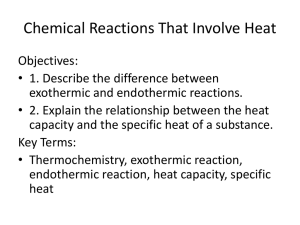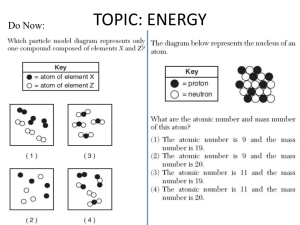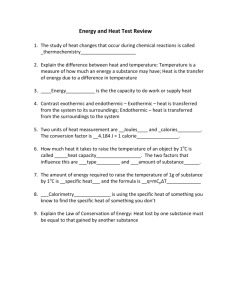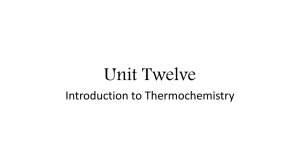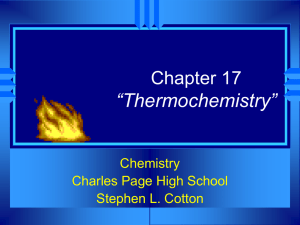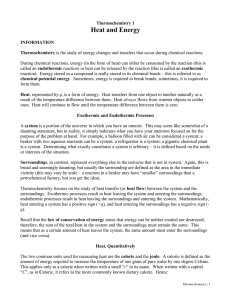Thermo notes part 1
advertisement
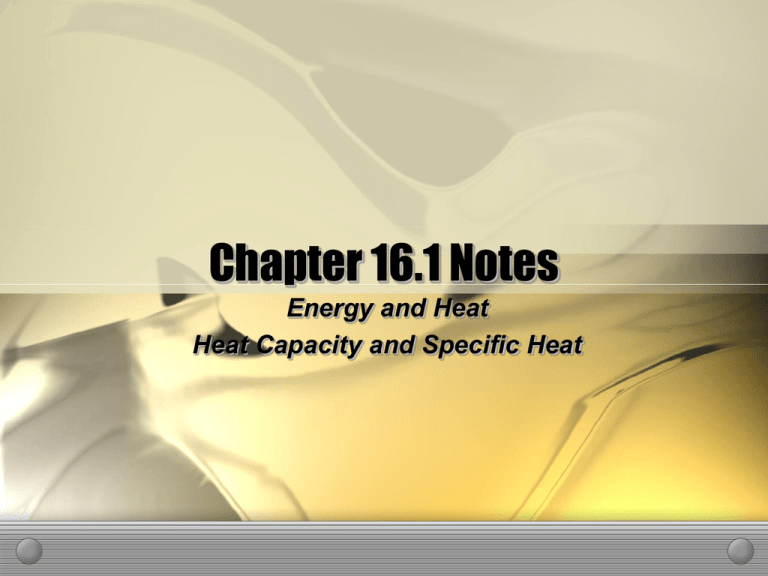
Chapter 16.1 Notes Energy and Heat Heat Capacity and Specific Heat Thermochemistry • This chapter deals with studying heat changes that occur during chemical reactions, which is defined as thermochemistry. This guy is enjoying the sun; the sun is an example of thermochemistry in action. A few thermo terms… • Energy-the capacity to do work or supply heat • Chemical Potential Energy-stored energy in the bonds of chemical compounds • Heat (q)-energy that transfers due to a difference in temperature (remember we already defined temperature as the measure of how much energy something has) Exothermic reactions • When heat is transferred from the system to the surroundings during a reaction, it is called exothermic. Combustion is exothermic. Only YOU can prevent forest fires. Endothermic reactions • When heat is transferred from the surroundings to the system during a reaction, it is called endothermic. Measuring Heat • There are two units of measurement we will discuss when calculating heat (q). • calories- a calorie is the amount of heat it takes to raise one gram of water by one degree celsius • (note: this is different from a food Calorie, which is actually 1 kilocalorie) • Joules (SI)- 4.184 Joules = 1 calorie Heat Capacity • How much heat it takes to raise the temperature of an object by 1oC is called its heat capacity. • What variables affect heat capacity? – Amount of substance – Type of substance Specific heat capacity (a.k.a.) specific heat • Scientists do not generally like to compare heat capacities, because there are two different variables, SO they compare 1g of substances to come up with the specific heat capacity. As you can see, scientists like Einstein do not like two variables! Specific heat • The amount of energy required to raise the temperature of 1g of substance by 1oC is its specific heat. • The formula for specific heat is: q=(m)(Cp)(DT) Heat = mass x specific heat x change in temp. Specific heat, cont.d • When solved for C, you get: q__ Cp = (m)(DT) Practice Problem #1 • When 435J of heat is added to 3.4g of olive oil, it raises the temperature from 21oC to 85oC. What is the specific heat of olive oil? Practice Problem #2 • A 1.55g piece of stainless steel absorbs 141J of heat when its temperature is increased by 178oC. What is the specific heat of the stainless steel? Mr. Huggins’s morning coffee increases the temperature of his travel mug. Chemistry in action! Practice Problem #3 • How much heat is lost when a 250.0g sample of mercury’s temperature is lowered by 52oC? CHg=0.14 J/goC Mercury was once used in the hat making industry, but the vapors reacted with employee nervous systems and drove them insane. Hence the phrase, mad as a hatter.


